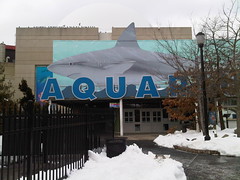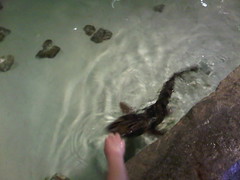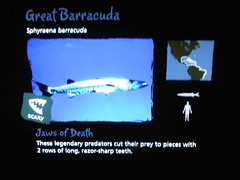
Old entrance with VSBA visual branding design
A Valentine’s Day visit to Adventure Aquarium in Camden prompted me to write about my experience, in a piece that I thought would be an evaluation of a nonprofit organization falling into the “Zoos and Aquariums” category. After some cursory research I found that Adventure Aquarium is owned and operated by a commercial corporation. Having started its life as the New Jersey State Aquarium, a nonprofit organization, it is a relative youngster amongst the larger cultural orgs in the region, opening only in 1992 (read more here). I knew that something was up when I searched for their most recent 990 form, and the best that I could find was a document from 2003, which had most of the information redacted from it. But I still have a lot to say about the visitor experience, and I believe that there are some lessons visual arts organizations could take from the field of “living collection” institutes.

The Shark Tunnel
The first thing that you notice when you enter Adventure Aquarium is that it’s crowded and about every other person is pushing a stroller (we were there on a holiday that fell on a weekend). You are funneled first through the cafeteria and the air is heavy with the scent of fried food. A visitor can then make his or her way to a number of “adventure zones”. Kids are everywhere: they are excited and loving the experience, pointing at animals and “ooh-ing”; some seem a little bit scared or timid about the scarier sea life. There are lots of adults too, mostly youngish couples, and maybe a few gangs of teens.

For this kind of hybrid educational/adventure experience, it feels like there is no way that a visual or performing arts organization can beat a zoo or aquarium. At Adventure Aquarium, you can touch a shark, ogle hippopotami, and stare at all other kinds of sea life, large and small. And penguins—how can you compete with penguins? It’s impossible; even film producers know as much. It can be no coincidence that the shelves of the gift shop have been lined with any kind of stuffed penguin you could imagine.

In all, it is an immersive experience into which people of all ages can lose themselves. Though I don’t have any solutions, arts administrators should think carefully about how we can evoke this type of experience at a museum or theater. When a parent says to their kid, “We’re going to the Art Museum!” it should elicit the same type of glee as proclaiming a visit to the aquarium.

"Touch a Shark"
But I do feel that the educational experience at Adventure Aquarium suffers for the fact that they have become a for-profit entity. It exists sporadically, but it is clearly ancillary. Staff on hand to facilitate touching of sharks or feeding of birds do more barking out of rules for interaction, rather than interpreting and informing about the animals; it felt anonymous and assembly line, if you will: “you fed the bird, great! Next in line and keep it moving…” In another example, some tanks had no labels as to the type of fish that are in them, and those that do are very simplistic. I feel that you need to give simple, bullet-point information for the casual user and younger reader, but offer more detailed description for those who are interested. I see this as an area where content for smart phones can be employed, with the option to access extra information to augment a visitor’s experience.

Wall text example
There exists a greater intangible related to these examples: the fact that Adventure Aquarium no longer exists for the purpose of science, learning, and serving the community. A place like Mystic Aquarium has a certain gravitas, enabled by the fact that it and its partner, the highly respectable undersea explorer Robert Ballard’s Institute for Exploration, is operated by the Sea Research Foundation, a nonprofit organization. But at Adventure Aquarium, the visitor experience, even the fun to be had, is transparently commoditized. Serving a greater good has become obfuscated in the quest for the bottom line. This is not to say that we do not care about making money, at least to the point of covering expenditures, at a nonprofit. Even though losses are regularly swallowed, and sometimes the norm, earned income is still an important component of the revenue stream, all in the service of a greater purpose: the mission.


No comments:
Post a Comment